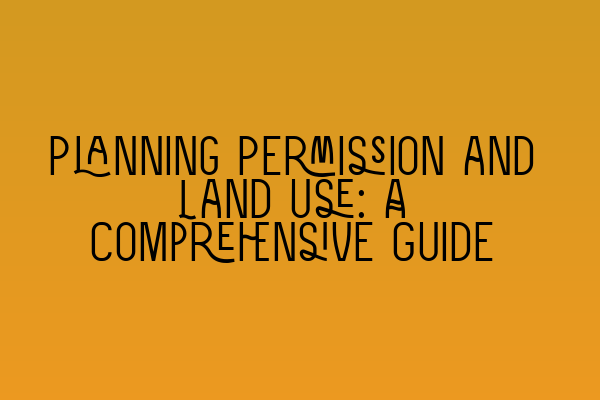Planning Permission and Land Use: A Comprehensive Guide
Introduction:
When it comes to property development or any change in land use, obtaining planning permission is a crucial step. Understanding the planning permission process and the regulations surrounding land use is essential to ensure compliance with the law.
In this comprehensive guide, we will take you through the intricacies of planning permission and land use, providing you with a detailed understanding of the subject. Whether you are a homeowner considering an extension, a property developer embarking on a new project, or simply interested in the legal aspects of land use, this guide will provide you with valuable insights.
Let’s dive in!
1. What is Planning Permission?
Planning permission is the formal permission required from the local planning authority to carry out a development or change the use of land or buildings. It ensures that development aligns with local planning policies and regulations, supporting sustainable development and protecting the interests of the community.
2. Importance of Planning Permission:
Obtaining planning permission is crucial for several reasons:
a. Legality: Undertaking any development without the proper planning permission is considered a breach of planning regulations and can result in severe penalties.
b. Protection of Interests: Planning permission ensures that the development is suitable for the local area, taking into account factors such as infrastructure, environment, and community interests.
c. Property Value: Having planning permission adds value to your property, as it reassures potential buyers or tenants that the development complies with legal requirements.
3. Applying for Planning Permission:
The planning permission process involves the following steps:
a. Pre-Application: Prior to submitting a formal application, it is advisable to engage with the local planning authority to discuss your proposal and seek their advice.
b. Application Submission: Once you have finalized your plans, you can submit your application to the local planning authority. The application should include relevant documents, such as drawings, supporting reports, and a completed application form.
c. Consideration and Consultation: The local planning authority will review your application, consulting with various stakeholders and considering factors such as impact on the local area, traffic, environment, and community interests.
d. Decision: The local planning authority will make a decision on your application, which can either be granted, granted with conditions, or refused. If refused, you have the option to appeal the decision.
4. Permitted Development:
Certain types of development are considered “permitted development” and do not require planning permission. Examples include minor home improvements, such as small extensions, loft conversions, and certain types of outbuildings. However, it is important to check the specific rules and limitations set by the local planning authority to ensure compliance.
5. Land Use and Zoning:
Land use is governed by zoning regulations, which outline the permitted uses for different areas. Zones can be designated for residential, commercial, industrial, or agricultural purposes, among others. Understanding the zoning regulations is essential when considering any change in land use or development.
6. Land Use Restrictions:
There may be specific restrictions or conditions imposed on land use, even within permitted development rights. These restrictions can vary from one area to another and can include limitations on the size, height, materials used, and visual impact of the development.
7. Environmental Considerations:
Planning permission takes into account environmental factors, such as impact on the natural habitat, water resources, and air quality. Developers may be required to undertake environmental impact assessments and implement mitigation measures to minimize any adverse effects.
8. Listed Buildings and Conservation Areas:
If the property falls within a designated conservation area or is a listed building, additional planning controls will apply. These controls aim to preserve the historical and architectural significance of the building or area.
Conclusion:
Navigating the planning permission process and understanding land use regulations can be complex, but it is essential for anyone involved in property development or considering a change in land use. By following the proper procedures and seeking professional advice when needed, you can ensure compliance with the law and maximize the potential of your property.
If you found this comprehensive guide helpful, you may also be interested in our related articles:
– SQE 1 Practice Exam Questions: [Link]
– SQE 1 Practice Mocks FLK1 FLK2: [Link]
– SQE 2 Preparation Courses: [Link]
– SQE 1 Preparation Courses: [Link]
– SRA SQE Exam Dates: [Link]
Remember, knowledge and compliance are the keys to successful planning permission and land use. If you have any questions or need professional assistance, don’t hesitate to reach out to our team at SQE Property Law & Land Law.
Disclaimer: This article is intended for informational purposes only and should not be construed as legal advice. Always consult with a qualified solicitor for specific legal guidance.
